The Economics and Statistics Division maintains archives of previous publications for accountability purposes, but makes no updates to keep these documents current with the latest data revisions from Statistics Canada. As a result, information in older documents may not be accurate. Please exercise caution when referring to older documents. For the latest information and historical data, please contact the individual listed to the right.
<--- Return to Archive
For additional information relating to this article, please contact:
February 11, 2020JAPAN CURRENT ACCOUNT, TRADE BALANCE, DECEMBER AND ANNUAL 2019 Current Account
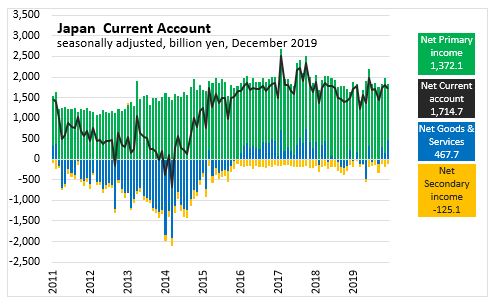
In December 2019, Japan reported
- Goods & services trade surplus widened by 307.5 billion yen to 468 billion yen
- Primary income surplus narrowed by 454 billion yen to 1,372 billion yen
- Secondary income deficit narrowed by 67 billion yen to 125 billion yen
- As a result, Current account surplus narrowed by 80 billion yen to 1,715 billion yen over November 2019.
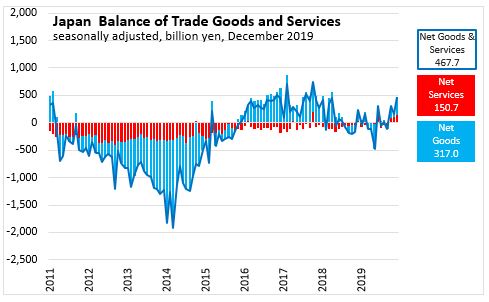
Trade Balance
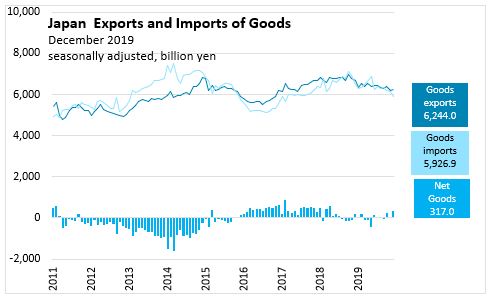
In December 2019, Japan 's
- Export goods trade increased by 52 billion yen to 6,244 billion yen
- Import goods trade decreased by 209 billion yen to 5,927 billion yen
- As a result, Net Goods trade surplus widened by 260 billion yen to 317 billion yen
- Net Services trade surplus widened by 47 billion yen to 151 billion yen
- As a result, Goods & services trade surplus widened by 307.5 billion yen to 468 billion yen over November 2019.
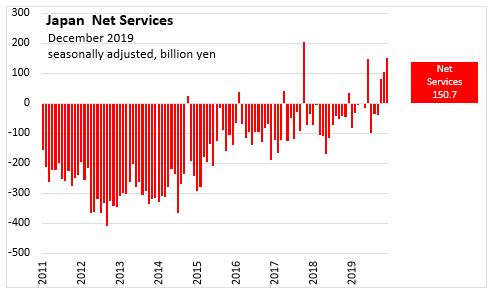
CURRENT ACCOUNT AS A SHARE OF GDP
The ratio of the current account balance to the Gross Domestic Product (or % of GDP) provides an indication of the country's trade and income flows relative to the size of the economy. The ratio is calculated by dividing the net values of exports less imports, primary Income (interest and dividends) and secondary income (transfers) over a period by the gross domestic product for the same period. Although called a ratio, it is usually expressed as a percentage. A current account surplus indicates upward pressure on the foreign exchange rate unless it is offset by net outflows (lending, acquisition of assets) outside the country.
- In the period 1999 Q1 to 2007 Q4, Japan's current account to GDP measure was positive,ranging from 1.7% to 4.8%.
- With the recession in 2008-2009, Japan's current account to GDP measure declined to a low of 1.6% in 2009 Q1 but quickly recovered to a local high of 4.1% in 2010 Q4.
- Over the next 13 quarters (2011 Q4 to 2014 Q1), Japan's current account to GDP measure declined to a low of -0.7%.
- Over the next 14 quarters (2014 Q1 to 2017 Q3), Japan's current account to GDP measure recovered to a new local high of 4.6% in 2017 Q3.
- In the period to 2019 Q4, Japan's current account to GDP measure has declined to 3.5%.
ANNUAL CURRENT ACCOUNT

In 2019, Japan reported
- Goods & services trade surplus widened by 337.5 billion yen to 729 billion yen
- Primary income surplus narrowed by 133 billion yen to 20,720 billion yen
- Secondary income deficit narrowed by 633 billion yen to 1,390 billion yen
- As a result, Current account surplus widened by 838 billion yen to 20,060 billion yen over 2018
ANNUAL TRADE BALANCE
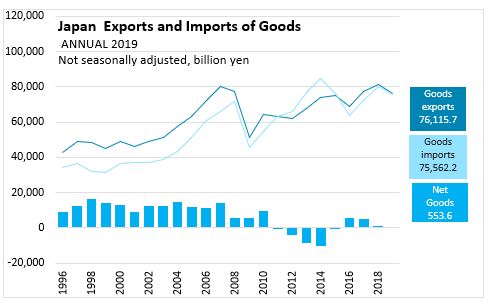
In 2019, Japan 's
- Export goods trade decreased by 5,123 billion yen to 76,116 billion yen
- Import goods trade decreased by 4,478 billion yen to 75,562 billion yen
- As a result, Net Goods trade surplus declined (645 billion yen) over 2018 to 554 billion yen..
MONTHLY
Report | Press Release | Balance of Payments
Based on Table 6s-a-2 Current Account (seasonally adjusted), Monthly
OECD BOP as a % of GDP
ANNUAL
Balance of Payments, Unadjusted
Based on Table 6s-a-2 Current Account (seasonally adjusted), Monthly
<--- Return to Archive